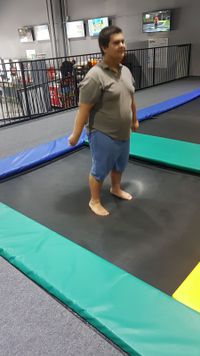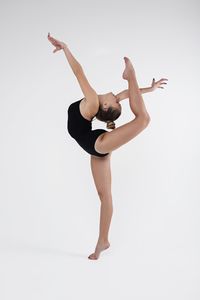Winstrada Development Programme: Difference between revisions
No edit summary |
No edit summary |
||
| (12 intermediate revisions by 5 users not shown) | |||
| Line 4: | Line 4: | ||
'''Top Contributors''' - {{Special:Contributors/{{FULLPAGENAME}}}} | '''Top Contributors''' - {{Special:Contributors/{{FULLPAGENAME}}}} | ||
</div> | </div> | ||
== Overview == | |||
The Winstrada Aesthetic Sports Development Foundation is the international body for the promotion and development of recreational and therapeutic gymnastics and trampolining. It's aim is to develop trampolining and gymnastics programmes that provide a resource to aid safe trampoline and gymnastic training and progressions <ref>Winstrada Development Scheme. Available from: [http://www.winstrada.com www.winstrada.com] (accessed 29 June 2019).</ref> | |||
== Overview == | |||
The Winstrada Aesthetic Sports Development Foundation is the international body for the promotion and development of recreational and therapeutic gymnastics and trampolining. | |||
It | |||
== Trampolining and Gymnastic Programme == | == Trampolining and Gymnastic Programme == | ||
| Line 15: | Line 11: | ||
== Winstrada Development Scheme and Rebound Therapy == | == Winstrada Development Scheme and Rebound Therapy == | ||
Grades 1, 2 and 3 of the Trampolining Programme have been adapted to match the exercises that form the basis of Rebound Therapy. | Grades 1, 2 and 3 of the Trampolining Programme have been adapted to match the exercises that form the basis of [[Rebound Therapy]]. | ||
Grade 1 focuses on foundational abilities and for the child to gain confidence with trampolining. Grade 2 looks at progressive movement patterns and higher level of spatial awareness. Grades 3 through to grade 10 focus on trampoline form and specific movements and routines.<ref>Smith E, Griggs G. Good Vibrations’: [https://www.researchgate.net/profile/Clive_Palmer/publication/277004162_Paper_7_Elizabeth_Smith_and_Gerald_Griggs_2009_Good_vibrations_the_effectiveness_of_teaching_rebound_therapy_to_children_with_profound_and_multiple_learning_difficulties_JQRSS_Volume_ The effectiveness of teaching rebound therapy to children with profound and multiple learning difficulties.] Journal of Qualitative Research in Sport Studies. 2010;3(1):91-104. </ref> | Grade 1 focuses on foundational abilities and for the child to gain confidence with trampolining. Grade 2 looks at progressive movement patterns and higher level of spatial awareness. Grades 3 through to grade 10 focus on trampoline form and specific movements and routines.<ref>Smith E, Griggs G. Good Vibrations’: [https://www.researchgate.net/profile/Clive_Palmer/publication/277004162_Paper_7_Elizabeth_Smith_and_Gerald_Griggs_2009_Good_vibrations_the_effectiveness_of_teaching_rebound_therapy_to_children_with_profound_and_multiple_learning_difficulties_JQRSS_Volume_ The effectiveness of teaching rebound therapy to children with profound and multiple learning difficulties.] Journal of Qualitative Research in Sport Studies. 2010;3(1):91-104. </ref> | ||
== Example of Trampolining Programme <ref name=":0">Winstrada Development Scheme Programmes. Available from: [http://www.winstrada.com/dev.php www.winstrada.com] (accessed 29 June 2019).</ref> == | Winstrada recently added a gymnastics development scheme for people with disabilities and pre-school age children. They are called the Primer grades. There are three grades: P1, P2 and P3. Further details can be found by following [https://winstrada.com/dev.php this link]. | ||
Grade 1 - | |||
== Example of Trampolining Programme <ref name=":0">Winstrada Development Scheme Programmes. Available from: [http://www.winstrada.com/dev.php www.winstrada.com] (accessed 29 June 2019).</ref> == | |||
[[File:Trampoline.jpg|thumb|356x356px]] | |||
Grade 1 - Section A | |||
1. Lies or sits on soft object eg beanbad | |||
2. Enjoys being bounce while lying or sitting on beanbag | |||
3. Enjoys movement with parachute | |||
4. Enjoys rocking motion of bed when lying down | |||
Section B | 5. Being bounced in back lying position- maintains shape | ||
Grade 2 - Section B | |||
7. Can achieve two footed jump – landing evenly | 7. Can achieve two footed jump – landing evenly | ||
| Line 45: | Line 45: | ||
12. Haka (fast knees up together and touch) | 12. Haka (fast knees up together and touch) | ||
== Example of the Gynmastics Programme<ref name=":0" /> == | == Example of the Gynmastics Programme<ref name=":0" /> == | ||
GYMNASTICS PROFICIENCY GRADE 3 | [[File:Gymnastics.jpg|thumb|300x300px]]GYMNASTICS PROFICIENCY GRADE 3 | ||
Minimal assistance may be given if required (awards 1-3 only). | Minimal assistance may be given if required (awards 1-3 only). | ||
| Line 68: | Line 68: | ||
10) Link a jump, roll and balance together. | 10) Link a jump, roll and balance together. | ||
== Intended Population == | == Intended Population == | ||
| Line 76: | Line 74: | ||
Grades 1,2 and 3 of the trampolining programmes can be used for Rebound Therapy in individuals with disabilities. | Grades 1,2 and 3 of the trampolining programmes can be used for Rebound Therapy in individuals with disabilities. | ||
== | == Measuring Progress == | ||
Progress is measured by simply ticking off completion of each movement within each section. A tick is granted when a student can competently perform a movement | Progress is measured by simply ticking off completion of each movement within each section. A tick is granted when a student can competently perform a movement. A Grade is completed once a student can successfully complete every move within that Grade. | ||
For individuals that have physical or intellectual challenges that are having Rebound Therapy. The Huddersfield Functional Index, which | For individuals that have physical or intellectual challenges that are having Rebound Therapy. The [[Huddersfield Functional Index]], which gives each movement for Grades 1, 2 and 3, a mark out of 4, would need to be used. | ||
== Links == | == Links == | ||
| Line 86: | Line 84: | ||
<references /> | <references /> | ||
[[Category:Outcome Measures]] | |||
[[Category:Course Pages]] | |||
[[Category:Plus Content]] | |||
Latest revision as of 19:22, 13 October 2022
Original Editor - Your name will be added here if you created the original content for this page.
Top Contributors - Mandy Roscher, Simisola Ajeyalemi, Kim Jackson, Tarina van der Stockt, Olajumoke Ogunleye and Robin Tacchetti
Overview[edit | edit source]
The Winstrada Aesthetic Sports Development Foundation is the international body for the promotion and development of recreational and therapeutic gymnastics and trampolining. It's aim is to develop trampolining and gymnastics programmes that provide a resource to aid safe trampoline and gymnastic training and progressions [1]
Trampolining and Gymnastic Programme[edit | edit source]
Both the trampolining and gymnastics programme are made up of 10 grades with each grade having a number of sections. Each section within a grade focuses on different movements or aspects of trampolining or gymnastics. A student must pass each movement within each section to progress.
Winstrada Development Scheme and Rebound Therapy[edit | edit source]
Grades 1, 2 and 3 of the Trampolining Programme have been adapted to match the exercises that form the basis of Rebound Therapy.
Grade 1 focuses on foundational abilities and for the child to gain confidence with trampolining. Grade 2 looks at progressive movement patterns and higher level of spatial awareness. Grades 3 through to grade 10 focus on trampoline form and specific movements and routines.[2]
Winstrada recently added a gymnastics development scheme for people with disabilities and pre-school age children. They are called the Primer grades. There are three grades: P1, P2 and P3. Further details can be found by following this link.
Example of Trampolining Programme [3][edit | edit source]
Grade 1 - Section A
1. Lies or sits on soft object eg beanbad
2. Enjoys being bounce while lying or sitting on beanbag
3. Enjoys movement with parachute
4. Enjoys rocking motion of bed when lying down
5. Being bounced in back lying position- maintains shape
Grade 2 - Section B
7. Can achieve two footed jump – landing evenly
8. Can achieve two footed jumps repeatedly – landing evenly
9. Perform 3 bounces – stop – stillness
10. Standing position – bounce with quarter twists
11. Pogo – moving around trampoline, understands and performs forwards, backwards and sideways movements
12. Haka (fast knees up together and touch)
Example of the Gynmastics Programme[3][edit | edit source]
GYMNASTICS PROFICIENCY GRADE 3
Minimal assistance may be given if required (awards 1-3 only).
To gain the award, complete 8 of the skills below.
1) Balance on back in a dish shape.
2) Bunny hop into and out of hoops.
3) Balance on tummy in arch shape.
4) Roll forwards from squat position.
5) Rock backwards from seated tuck position. 6) Front support, jump feet in between hands. 7) Hula hoop.
8) Action song to music.
9) At least 3 skips over rope turned by teachers.
10) Link a jump, roll and balance together.
Intended Population[edit | edit source]
The Trampolining Programme and Gymnastics Programme were developed for all levels of individuals from very basic (Grade 1) to advanced (Grade 10).
Grades 1,2 and 3 of the trampolining programmes can be used for Rebound Therapy in individuals with disabilities.
Measuring Progress[edit | edit source]
Progress is measured by simply ticking off completion of each movement within each section. A tick is granted when a student can competently perform a movement. A Grade is completed once a student can successfully complete every move within that Grade.
For individuals that have physical or intellectual challenges that are having Rebound Therapy. The Huddersfield Functional Index, which gives each movement for Grades 1, 2 and 3, a mark out of 4, would need to be used.
Links[edit | edit source]
The programme and posters are freely available at the Winstrada Website.
References[edit | edit source]
- ↑ Winstrada Development Scheme. Available from: www.winstrada.com (accessed 29 June 2019).
- ↑ Smith E, Griggs G. Good Vibrations’: The effectiveness of teaching rebound therapy to children with profound and multiple learning difficulties. Journal of Qualitative Research in Sport Studies. 2010;3(1):91-104.
- ↑ 3.0 3.1 Winstrada Development Scheme Programmes. Available from: www.winstrada.com (accessed 29 June 2019).








